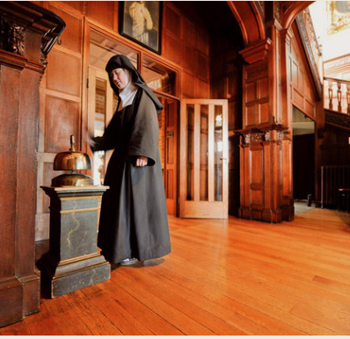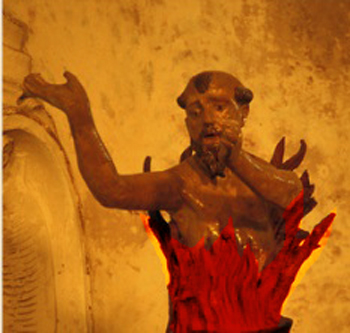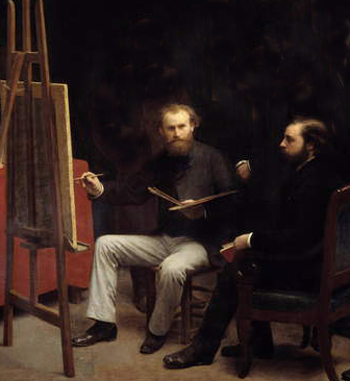Stories & Legends
 |
 |
 |
 |
 |
 |
 |
The Grave Consequences of One Bad Painting
Those who have had the misfortune to give bad example, and thus to wound or cause the perdition of souls by scandal, must take care to repair for their wrongdoing in this world, in order not to be subjected to the most terrible expiation in the next.
It was not in vain that Jesus Christ cried out, “Woe to the world because of scandals! Woe to that man by whom the scandal cometh." (Mt 18:7)
Hear, then, what Father Rossignoli relates in his Merveilles du Purgatoire.
A painter of great skill and otherwise exemplary life had once made a painting not at all conformable to the strict rules of Christian modesty. It was one of those paintings which, under the pretext of being works of art, are found in the best families, and the sight of which causes the loss of so many souls.

 True art is an inspiration from Heaven, and elevates the soul to God; profane art, which appeals to the senses only and presents to the eye nothing but the beauties of flesh and blood, is but an inspiration of the evil spirit. Such works, brilliant though they may be, are not works of art, and the name is falsely attributed to them. They are the infamous productions of a corrupt imagination.
True art is an inspiration from Heaven, and elevates the soul to God; profane art, which appeals to the senses only and presents to the eye nothing but the beauties of flesh and blood, is but an inspiration of the evil spirit. Such works, brilliant though they may be, are not works of art, and the name is falsely attributed to them. They are the infamous productions of a corrupt imagination.
The artist of whom we speak had allowed himself in his youth to be misled in this point by bad example. Soon, however, renouncing this pernicious style, he confined himself to the production of religious pictures that were completely irreproachable.
When he was painting a large painting in a convent of the discalced Carmelites, he was attacked by a mortal malady. Feeling that he was about to die, he asked the Prior to allow him to be interred in the church of the monastery, and bequeathed to the community his earnings, which amounted to a considerable sum of money, charging them to have Masses said for the repose of his soul. He died in pious sentiments.
A few days had passed when a Religious who had remained that day in the choir after Matins saw him appear in the midst of flames and sighing piteously.
"What is this? " asked the Religious. “Why must you endure such pain, after leading so good a life and dying so holy a death?"
"Alas !" replied he, "it is on account of the immodest picture that I painted some years ago. When I appeared before the tribunal of the Sovereign Judge, a group of accusers came to give evidence against me. They declared that they had been excited to improper thoughts and evil desires by a picture, the work of my hand.
“As a consequence of those bad thoughts some were in Purgatory, and yet others in Hell. The latter cried for vengeance, saying that since I had been the cause of their eternal perdition, I deserved, at least, the same punishment.
“Then the Blessed Virgin and the Saints whom I had glorified by my pictures took up my defense. They argued before the Judge that that unfortunate painting had been the work of my youth, and that I had repented for it, repairing for it afterwards by painting religious objects that had been a source of edification to souls.
"In consideration of these and other reasons, especially the devotion I had always shown to Our Lady, the Sovereign Judge declared that, on account of my repentance and my good works, I should escape damnation. At the same time, He condemned me suffer these flames until that picture should be burned, so that it could no longer scandalize anyone else." Then the poor sufferer implored the Religious to take measures to have the painting destroyed.
 "I beg of you," he continued, “to go in my name to Mr. X, who owns the picture. Tell him of my condition and the suffering I undergo for having yielded to his entreaties to paint it. Plead with him to make a sacrifice of it. If he refuses, woe to him!
"I beg of you," he continued, “to go in my name to Mr. X, who owns the picture. Tell him of my condition and the suffering I undergo for having yielded to his entreaties to paint it. Plead with him to make a sacrifice of it. If he refuses, woe to him!
“To prove that this is not an illusion and to punish him for his own fault, tell him that before long he will lose his two children. Should he refuse to obey the good God who has created us both, he will pay for it by a premature death."
The Religious delayed not to do what the poor soul had asked of him, and went to the owner of the picture.
The latter, on hearing these things, seized the painting and cast it into the fire. Nevertheless, just as the deceased artist had foretold, he lost his two children in less than a month.
The remainder of his days he passed in penance, for having ordered and kept that immodest picture in his house.
If such are the consequences of an immodest picture, what, then, will be the punishment of the still more disastrous scandals resulting from bad books, bad papers, bad schools and bad conversations?
Vae mundo a scandalis. Vae homini illi per quem scandalum venit! — Woe to the world because of scandals ! Woe to that man by whom the scandal cometh!"



It was not in vain that Jesus Christ cried out, “Woe to the world because of scandals! Woe to that man by whom the scandal cometh." (Mt 18:7)
Hear, then, what Father Rossignoli relates in his Merveilles du Purgatoire.
A painter of great skill and otherwise exemplary life had once made a painting not at all conformable to the strict rules of Christian modesty. It was one of those paintings which, under the pretext of being works of art, are found in the best families, and the sight of which causes the loss of so many souls.

A sister who stayed behind at Matins saw the painter appear wrapped in flames

The artist of whom we speak had allowed himself in his youth to be misled in this point by bad example. Soon, however, renouncing this pernicious style, he confined himself to the production of religious pictures that were completely irreproachable.
When he was painting a large painting in a convent of the discalced Carmelites, he was attacked by a mortal malady. Feeling that he was about to die, he asked the Prior to allow him to be interred in the church of the monastery, and bequeathed to the community his earnings, which amounted to a considerable sum of money, charging them to have Masses said for the repose of his soul. He died in pious sentiments.
A few days had passed when a Religious who had remained that day in the choir after Matins saw him appear in the midst of flames and sighing piteously.
"What is this? " asked the Religious. “Why must you endure such pain, after leading so good a life and dying so holy a death?"
"Alas !" replied he, "it is on account of the immodest picture that I painted some years ago. When I appeared before the tribunal of the Sovereign Judge, a group of accusers came to give evidence against me. They declared that they had been excited to improper thoughts and evil desires by a picture, the work of my hand.
“As a consequence of those bad thoughts some were in Purgatory, and yet others in Hell. The latter cried for vengeance, saying that since I had been the cause of their eternal perdition, I deserved, at least, the same punishment.
“Then the Blessed Virgin and the Saints whom I had glorified by my pictures took up my defense. They argued before the Judge that that unfortunate painting had been the work of my youth, and that I had repented for it, repairing for it afterwards by painting religious objects that had been a source of edification to souls.
"In consideration of these and other reasons, especially the devotion I had always shown to Our Lady, the Sovereign Judge declared that, on account of my repentance and my good works, I should escape damnation. At the same time, He condemned me suffer these flames until that picture should be burned, so that it could no longer scandalize anyone else." Then the poor sufferer implored the Religious to take measures to have the painting destroyed.

A friend enticed him to paint an immoral picture
“To prove that this is not an illusion and to punish him for his own fault, tell him that before long he will lose his two children. Should he refuse to obey the good God who has created us both, he will pay for it by a premature death."
The Religious delayed not to do what the poor soul had asked of him, and went to the owner of the picture.
The latter, on hearing these things, seized the painting and cast it into the fire. Nevertheless, just as the deceased artist had foretold, he lost his two children in less than a month.
The remainder of his days he passed in penance, for having ordered and kept that immodest picture in his house.
If such are the consequences of an immodest picture, what, then, will be the punishment of the still more disastrous scandals resulting from bad books, bad papers, bad schools and bad conversations?
Vae mundo a scandalis. Vae homini illi per quem scandalum venit! — Woe to the world because of scandals ! Woe to that man by whom the scandal cometh!"

Better to burn immoral works
than burn in Purgatory or Hell

Fr. F.X. Schouppe, Purgatory Illustrated by the Lives and Legends of the Saints,
Chap. 31, “The Mystery of Justice,” London, 1920.
Posted July 6, 2024
Chap. 31, “The Mystery of Justice,” London, 1920.
Posted July 6, 2024






